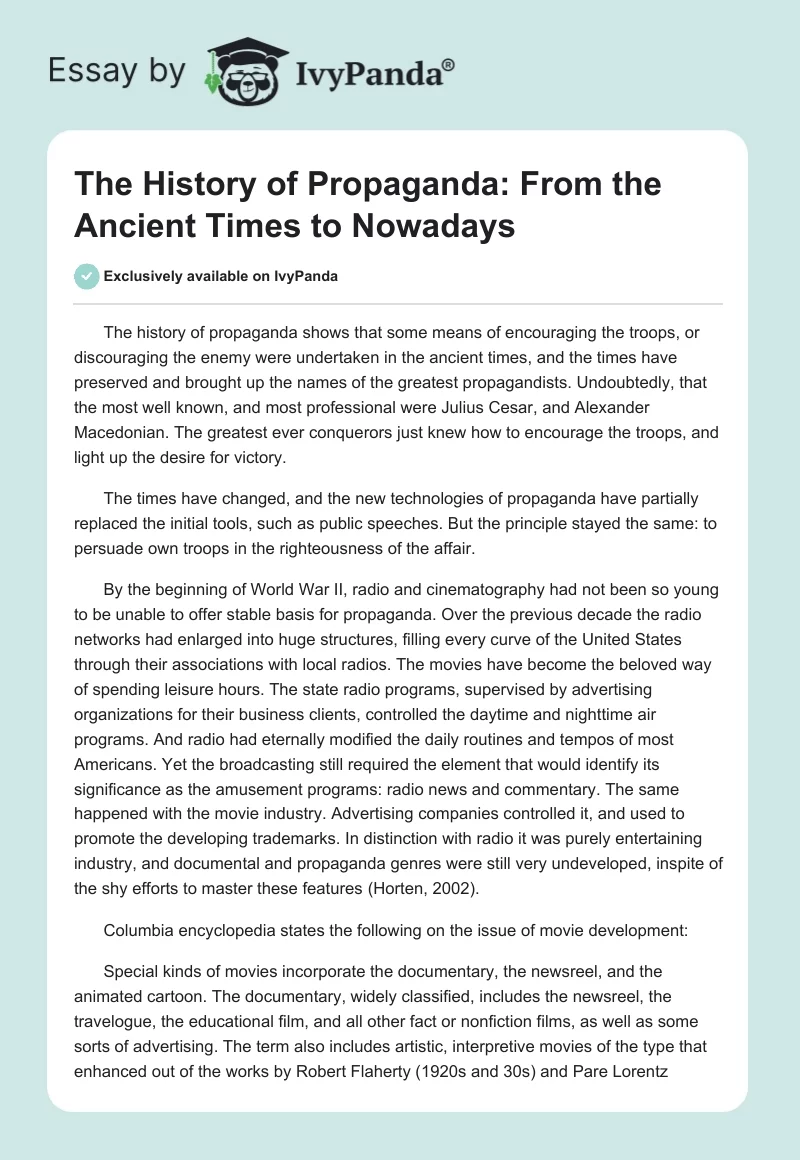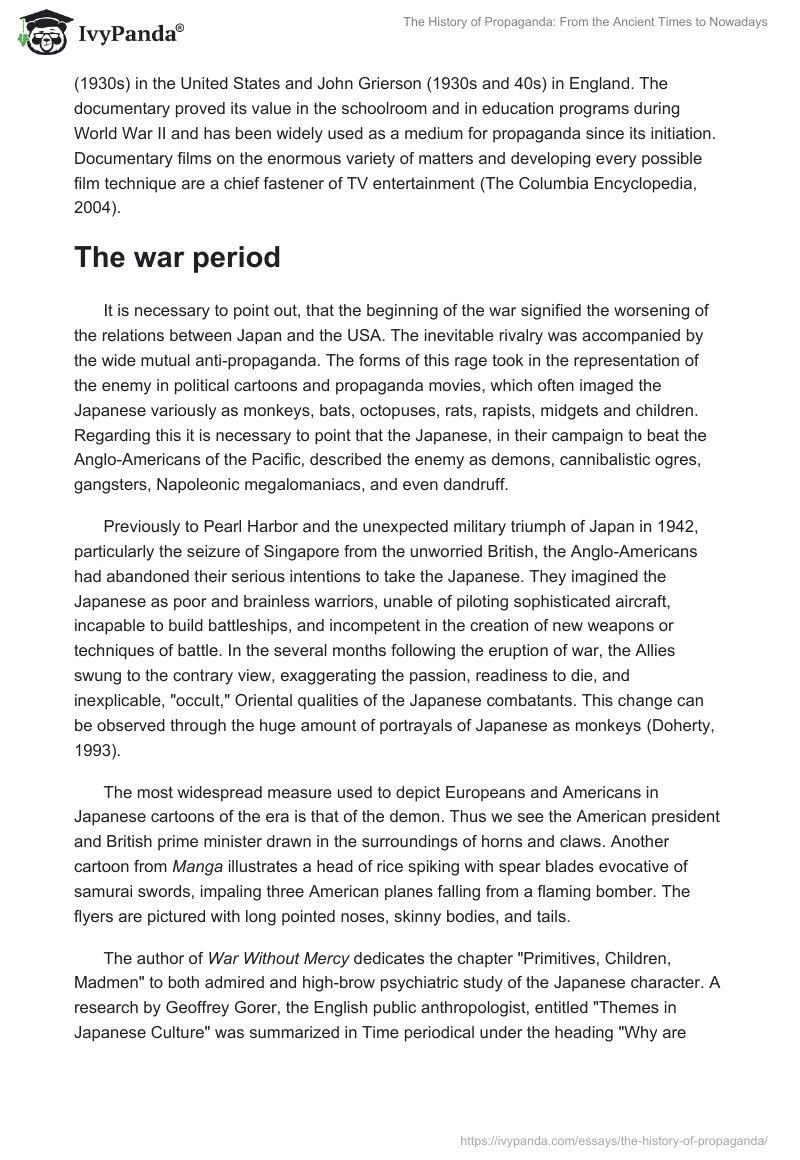The history of propaganda shows that some means of encouraging the troops, or discouraging the enemy were undertaken in the ancient times, and the times have preserved and brought up the names of the greatest propagandists. Undoubtedly, that the most well known, and most professional were Julius Cesar, and Alexander Macedonian. The greatest ever conquerors just knew how to encourage the troops, and light up the desire for victory.
The times have changed, and the new technologies of propaganda have partially replaced the initial tools, such as public speeches. But the principle stayed the same: to persuade own troops in the righteousness of the affair.
By the beginning of World War II, radio and cinematography had not been so young to be unable to offer stable basis for propaganda. Over the previous decade the radio networks had enlarged into huge structures, filling every curve of the United States through their associations with local radios. The movies have become the beloved way of spending leisure hours. The state radio programs, supervised by advertising organizations for their business clients, controlled the daytime and nighttime air programs. And radio had eternally modified the daily routines and tempos of most Americans. Yet the broadcasting still required the element that would identify its significance as the amusement programs: radio news and commentary. The same happened with the movie industry. Advertising companies controlled it, and used to promote the developing trademarks. In distinction with radio it was purely entertaining industry, and documental and propaganda genres were still very undeveloped, inspite of the shy efforts to master these features (Horten, 2002).
Columbia encyclopedia states the following on the issue of movie development:
Special kinds of movies incorporate the documentary, the newsreel, and the animated cartoon. The documentary, widely classified, includes the newsreel, the travelogue, the educational film, and all other fact or nonfiction films, as well as some sorts of advertising. The term also includes artistic, interpretive movies of the type that enhanced out of the works by Robert Flaherty (1920s and 30s) and Pare Lorentz (1930s) in the United States and John Grierson (1930s and 40s) in England. The documentary proved its value in the schoolroom and in education programs during World War II and has been widely used as a medium for propaganda since its initiation. Documentary films on the enormous variety of matters and developing every possible film technique are a chief fastener of TV entertainment (The Columbia Encyclopedia, 2004).
The war period
It is necessary to point out, that the beginning of the war signified the worsening of the relations between Japan and the USA. The inevitable rivalry was accompanied by the wide mutual anti-propaganda. The forms of this rage took in the representation of the enemy in political cartoons and propaganda movies, which often imaged the Japanese variously as monkeys, bats, octopuses, rats, rapists, midgets and children. Regarding this it is necessary to point that the Japanese, in their campaign to beat the Anglo-Americans of the Pacific, described the enemy as demons, cannibalistic ogres, gangsters, Napoleonic megalomaniacs, and even dandruff.
Previously to Pearl Harbor and the unexpected military triumph of Japan in 1942, particularly the seizure of Singapore from the unworried British, the Anglo-Americans had abandoned their serious intentions to take the Japanese. They imagined the Japanese as poor and brainless warriors, unable of piloting sophisticated aircraft, incapable to build battleships, and incompetent in the creation of new weapons or techniques of battle. In the several months following the eruption of war, the Allies swung to the contrary view, exaggerating the passion, readiness to die, and inexplicable, “occult,” Oriental qualities of the Japanese combatants. This change can be observed through the huge amount of portrayals of Japanese as monkeys (Doherty, 1993).
The most widespread measure used to depict Europeans and Americans in Japanese cartoons of the era is that of the demon. Thus we see the American president and British prime minister drawn in the surroundings of horns and claws. Another cartoon from Manga illustrates a head of rice spiking with spear blades evocative of samurai swords, impaling three American planes falling from a flaming bomber. The flyers are pictured with long pointed noses, skinny bodies, and tails.
The author of War Without Mercy dedicates the chapter “Primitives, Children, Madmen” to both admired and high-brow psychiatric study of the Japanese character. A research by Geoffrey Gorer, the English public anthropologist, entitled “Themes in Japanese Culture” was summarized in Time periodical under the heading “Why are Japs Japs?” Other publications in American journals gave such titles as “Jap Cruelty Traced to Childhood,” “Jap Bullies,” and “How to Tell Japs from Chinese”.
References
- “Motion Pictures.” The Columbia Encyclopedia. 6th ed. 2004.
- Horten, Gerd. Radio Goes to War: The Cultural Politics of Propaganda during World War II. Berkeley, CA: University of California Press, 2002.
- Doherty, Thomas “Know Your Enemy:Japan 1945” ,Thomas DohertyProjections OF War(1993)


